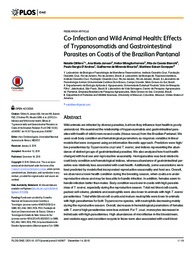Co-infection and wild animal health: effects of Trypanosomatids and gastrointestinal parasites on coatis of the Brazilian Pantanal.
Co-infection and wild animal health: effects of Trypanosomatids and gastrointestinal parasites on coatis of the Brazilian Pantanal.
Author(s): OLIFIERS N.; JANSEN A. M.; HERRERA H. M.; BIANCHI, R. de C.; D'ANDREA P. S.; MOURAO, G.
Summary: Wild animals are infected by diverse parasites, but how they influence host health is poorly understood. We examined the relationship of trypanosomatids and gastrointestinal parasites with health of wild brown-nosed coatis (Nasua nasua) from the Brazilian Pantanal. We used coati body condition and hematological parameters as response variables in linear models that were compared using an information theoretic approach. Predictors were high/low parasitemias by Trypanosoma cruzi and T. evansi, and indices representing the abundance of distinct groups of gastrointestinal parasites. We also analyzed how host health changed with host sex and reproductive seasonality. Hemoparasites was best related to coati body condition and hematological indices, whereas abundance of gastrointestinal parasites was relatively less associated with coati health. Additionally, some associations were best predicted by models that incorporated reproductive seasonality and host sex. Overall, we observed a lower health condition during the breeding season, when coatis are under reproductive stress and may be less able to handle infection. In addition, females seem to handle infection better than males. Body condition was lower in coatis with high parasitemias of T. evansi, especially during the reproductive season. Total red blood cell counts, packed cell volume, platelets and eosinophils were also lower in animals with high T. evansi parasitemias. Total white blood cell counts and mature neutrophils were lower in animals with high parasitemias for both Trypanosoma species, with neutrophils decreasing mainly during the reproductive season. Overall, decreases in hematological parameters of females with T. evansi high parasitemias were less evident. For T. cruzi, monocytes decreased in individuals with high parasitemias. High abundances of microfilariae in the bloodstream, and cestode eggs and coccidian oocysts in feces were also associated with coati blood.
Publication year: 2015
Types of publication: Journal article
Unit: Embrapa Pantanal
Keywords: Chagas disease, Disease vectors, Quati, Quatis, Vetor
Observation
Some of Embrapa's publications are published as ePub files. To read them, use or download one of the following free software options to your computer or mobile device. Android: Google Play Books; IOS: iBooks; Windows and Linux: Calibre.
Access other publications
Access the Agricultural Research Database (BDPA) to consult Embrapa's full library collection and records.
Visit Embrapa Bookstore to purchase books and other publications sold by Embrapa.

